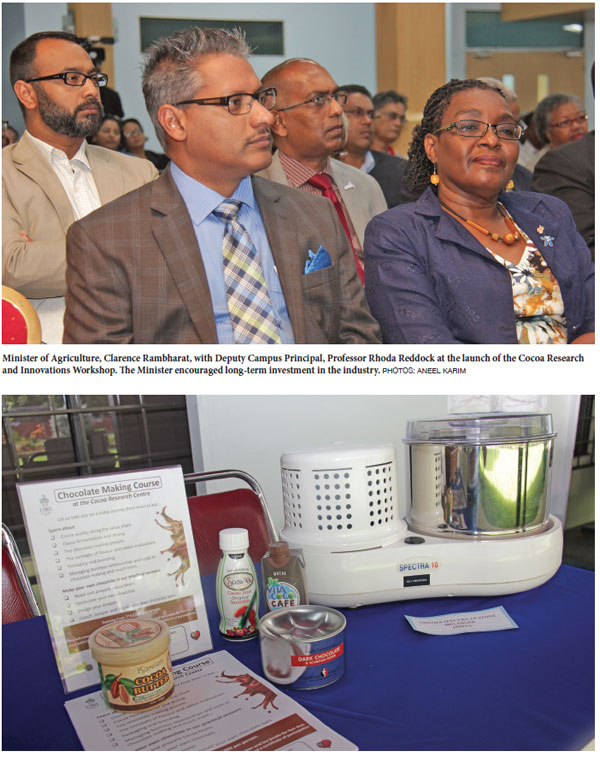

 The Cocoa Research Centre (CRC) scored a major feat on November 17 when representatives along the cocoa value chain in Trinidad and Tobago, and a few from the region, met under one roof for a good old-fashioned powwow. The Cocoa Research Centre (CRC) scored a major feat on November 17 when representatives along the cocoa value chain in Trinidad and Tobago, and a few from the region, met under one roof for a good old-fashioned powwow.
The event occurred on November 17 at The University Inn and Conference Centre, not far from CRC’s St. Augustine Campus home, located in the Sir Frank Stockdale building.
Everyone agreed it was high time the people in cocoa met and talked. But the people in cocoa were also resolute that the time had passed for mere talk. There is, after all, an industry to revive.
The Cocoa Research and Innovations Workshop brought together researchers, cocoa farmers, cocoa entrepreneurs and aspiring entrepreneurs, chocolatiers, technocrats, and even politicians under the theme “From Lab to Farm to Product.” Major sponsors included the Dutch Embassy and Atlantic LNG.
Professor Pathmanathan Umaharan, Director of the CRC, whose institutional knowledge of the local cocoa industry is unsurpassed, identified where Trinidad and Tobago currently finds itself, compared to the glory days of 1921. Back then, this country produced 35,000 metric tonnes of cocoa, making it the fourth largest producer of cocoa in the world. Today we produced 500-600 metric tonnes.
What happened? Witch’s broom.
“Witch’s broom had a devastating influence on production,” Umaharan, a professor in genetics, explained. This plant disease or deformity changes the natural structure of the plant causing a dense mass of shoots to grow out from a single point. The resemblance to a witch’s broom is believed to account for the name.”
The fact that The UWI, through the Cocoa Research Centre, is championing the revival of cocoa in Trinidad and Tobago isn’t news, since The UWI has, arguably, always been there for cocoa.
It was the Imperial College of Tropical Agriculture, the forerunner to The University of the West Indies, which formed part of the early architects of T&T’s comeback in cocoa. In 1930, the College established a research programme determined to reverse the crop’s misfortunes on the island. Researchers were sent to Columbia, Bolivia, Ecuador, and Peru to collect wild varieties of cocoa germplasm. Upon their return, these researchers transplanted these varieties in the Marpar Farms in Sangre Grande.
“It was felt that if the tree survived that condition, it should have resistance,” Professor Umaharan said. Thankfully, there were survivors, and these were crossed to develop varieties for resistance and good yield and planted in farms across Trinidad and Tobago. Those interventions have resulted in this country now being recognised by Biodiversity International as having the largest and most diverse collection of cocoa anywhere in the world. Centeno is home to an International Cocoa Genebank which has 2,400 varieties of cocoa collected from all over the world on a 100-acre piece of land.
Deputy Principal, Professor Rhoda Reddock, representing The UWI St. Augustine Campus Principal, Professor Clement Sankat, paid tribute to the Trinitario cocoa – globally regarded as the basis for the burgeoning fine cocoa industry.
“Based on this, Trinidad has enjoyed a global reputation for the quality of cocoa it produces that fetches as much as three times premium in the global market over bulk cocoa,” Professor Reddock said in her welcome remarks.
During the mini-workshops, participants were enriched with testimonials and information from an impressive line-up of panellists and moderators.
In the session titled “Quality Matters,” Kampta Persaud owner of the 750-acre San Juan Cocoa Estate in Gran Couva, Trinidad, underscored the importance of meeting international quality standards.
“If we’re not going to meet the standards, we’re not going to be able to sell our cocoa at a good price. We may not be able to sell our cocoa at all,” Persaud said.
It was a sentiment that Jude Lee Sam of the Montserrat Cocoa Farmers’ Co-operative Society Limited (MCFCSL), shared.
“The standards are there,” Lee Sam said. “The thing is the commitment to do it and to do it all the time.” The MCFCSL, a Trinidad and Tobago-based co-operative, produces up to 40 metric tonnes of cocoa annually to a clientele of exclusive chocolate makers around the world.
In the workshop entitled, “There’s More to Cocoa than Chocolate,” participants heard the startup stories of chocolatier and founder of Cocobel Chocolate, Isabel Brash; the creator of Gina’s Truffles, Gina Hardy, and Founder of Café Mariposa, Marcia Guerrero. Moderator of the session, Managing Director of the Grenada-based Belmont Estate, Shadel Compton, also shared her Agri-Tourism business model which has won Trip Advisor Certificates of Excellence.
There were also mini workshops on innovations in disease management, raising yield potential, cadmium and trade Implications, and branding and traceability.
So, is T&T’s cocoa and the chocolate really the best? Participants assessed the assertion in live taste tests. Guess what? We won!
|





